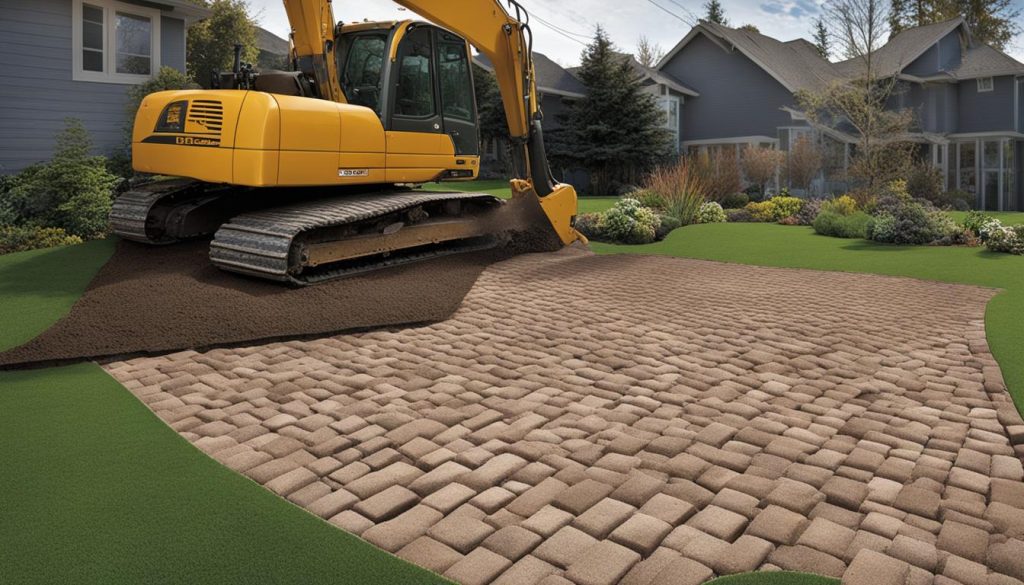Welcome to our article on interlocking base preparation, where we’ll explore how proper base preparation can help you achieve long-lasting and aesthetically pleasing interlocking installations. At Interlocking Contractor, we know that interlocking pavers are a popular choice among Canadian homeowners for their durability and versatility. However, a key factor in ensuring that your interlocking pavers remain durable and visually appealing over time is proper base preparation.
Interlocking base preparation is the foundation of any interlocking installation project. Without proper base preparation, even the best-quality interlocking pavers will eventually fail, leading to unsightly and costly repairs. Moreover, an improperly prepared base can cause interlocking pavers to shift, sink, or even crack, compromising the integrity and safety of the installation.
That’s why in this section, we’ll explain the significance of interlocking base preparation, the key steps involved, and the materials commonly used. By the end of this section, you’ll have a better understanding of why interlocking base preparation is so important for durable and aesthetically pleasing interlocking installations.
Understanding the Significance of Interlocking Base Preparation
When it comes to achieving durable and aesthetically pleasing interlocking installations, proper base preparation is essential. The significance of interlocking base preparation cannot be overstated as it plays a crucial role in ensuring the longevity of interlocking pavers and the overall performance of the installation.
The importance of base preparation lies in the fact that it creates a stable and level foundation that can withstand the weight of vehicular and pedestrian traffic. Without adequate base preparation, interlocking pavers can sink, shift, or crack over time, leading to costly repairs and replacements.
Interlocking longevity is directly tied to the quality of the base preparation. A well-prepared base can extend the life of interlocking installations by decades, making it a wise investment in the long run.
In addition to enhancing the durability of the installation, proper interlocking base preparation can also improve the aesthetics of the finished product. A level base with adequate drainage can ensure that the interlocking pavers remain stable and even, creating a seamless and visually appealing surface.

The Benefits of Proper Interlocking Base Preparation
The benefits of proper interlocking base preparation can be summarized as follows:
- Improved durability and longevity
- Enhanced aesthetics
- Increased stability
- Reduced risk of sinking, shifting, or cracking
- Easier maintenance and repair
By investing in proper interlocking base preparation, homeowners, contractors, and property owners can ensure that their interlocking installations remain functional and visually appealing for years to come.
Key Steps in Interlocking Base Preparation
If you want your interlocking installation to last for years to come, proper base preparation is crucial. Here are the key steps that we recommend when preparing the base for your interlocking pavers:
- Site Preparation: The first step is to prepare the site where the interlocking pavers will be installed. This involves removing any existing materials, such as concrete or asphalt, and grading the area to ensure a level surface.
- Excavation: Next, we excavate the area to the required depth, depending on the thickness of the pavers and the base materials that will be used. The excavation depth typically ranges from 6 to 12 inches.
- Soil Compaction: After excavating, we compact the soil to ensure that it is stable and able to support the weight of the pavers. A plate compactor or hand tamper can be used for this task.
- Geotextile Fabric Installation: We install a layer of geotextile fabric over the compacted soil. This helps to prevent soil movement and provides stability to the base layer. The fabric should overlap at the seams and be secured with landscape fabric pins.
- Gravel Base Installation: Next, we install a layer of gravel on top of the geotextile fabric. The thickness of the gravel layer will depend on the type of pavers being used. The gravel should be compacted using a plate compactor or hand tamper.
- Sand Base Installation: Finally, a layer of sand is installed on top of the gravel. The sand layer provides a smooth and level surface for the pavers to be laid on. This layer is also compacted using a plate compactor or hand tamper.
These steps are vital in ensuring that the base for your interlocking installation is prepared properly. Skipping steps or rushing through the process can result in an unstable base, which will cause problems down the line.
Our team of experienced interlocking contractors is well-versed in the interlocking installation process, including proper base preparation. We take pride in our work and guarantee that your interlocking pavers will be installed to the highest standards.

Materials Used in Interlocking Base Preparation
Choosing the right materials for interlocking base preparation is crucial for achieving a durable and long-lasting interlocking installation. At Interlocking Contractor, we use only high-quality materials that are suitable for the specific application and climate conditions.
- Geotextile Fabric: A non-woven synthetic material that is used to separate the native soil from the base material. It prevents soil movement and provides stability to the base.
- Gravel: Used as the base material for interlocking installations, gravel helps with drainage and provides a stable base for the pavers.
- Sand: Used to fill the joints between the pavers, sand provides stability and prevents shifting.
- Edge Restraints: Used to secure the perimeter of the installation, edge restraints prevent the pavers from shifting out of place.
When selecting base preparation materials, it is important to consider factors such as the soil type, the amount of foot and vehicle traffic, and the climate conditions. Our team of experts at Interlocking Contractor has the knowledge and experience to select the right materials for each project to ensure the best results.

Tips for Choosing the Right Materials for Your Interlocking Installation
If you are planning a DIY interlocking installation, it is important to choose the right materials to ensure the longevity and durability of the project. Here are some tips:
- Choose high-quality materials that are suitable for the specific soil type and climate conditions.
- Consider the amount of foot and vehicle traffic in the area and choose materials that can withstand the weight and pressure.
- Ensure that the materials are properly installed and compacted to prevent shifting and movement.
- Consult with a professional interlocking contractor to ensure that you are selecting the right materials for your project.
By following these tips and selecting the right materials, you can ensure a visually appealing and long-lasting interlocking installation.
Hiring a Professional Interlocking Contractor for Base Preparation
At Interlocking Contractor, we understand that interlocking base preparation is a crucial step in ensuring the longevity and durability of your interlocking installation. With years of experience in the field, our team of experts has the knowledge and skills to provide top-quality base preparation services that meet your specific requirements.
The Benefits of Hiring a Professional
When it comes to interlocking base preparation, hiring a professional contractor is the best way to ensure a high-quality outcome. Our team has the proper tools and equipment to excavate the site, compact the soil, and install geotextile fabric, gravel, sand, and edge restraints efficiently.
Additionally, our experts have the experience and expertise to identify and address any potential issues, such as poor drainage or unstable soil conditions, before they become major problems. We are committed to delivering the highest standards of workmanship and customer service and take pride in our ability to complete projects on time and on budget.
Our Interlocking Installation Services
In addition to interlocking base preparation, we offer a full range of interlocking installation services, including design consultation, material selection, and project management. Our team can help you create a beautiful and functional outdoor living space that enhances the value and curb appeal of your property.
Whether you need a new driveway, walkway, patio, or pool deck, we have the skills and expertise to deliver exceptional results. From the initial consultation to the final walk-through, we work closely with our clients to ensure their vision is brought to life.
Contact Us Today
If you are looking for a professional interlocking contractor for base preparation or installation services, look no further than Interlocking Contractor. We are dedicated to providing the highest level of service and quality workmanship in every project we undertake. Contact us today at (647) 812-9803 to schedule a consultation and get started on your dream outdoor space.
FAQ
What is the role of base preparation in interlocking installation?
Base preparation is crucial in achieving durable and aesthetically pleasing interlocking installations. It provides a stable foundation for the pavers, ensuring long-lasting performance and preventing issues such as settling or shifting.
Why is interlocking base preparation significant?
Interlocking base preparation is significant because it directly impacts the longevity of the installation. It helps distribute weight evenly, minimizes the risk of cracking or heaving, and promotes proper water drainage, preventing water damage and mold growth.
What are the key steps involved in interlocking base preparation?
The key steps in interlocking base preparation include site excavation, soil compaction, installing geotextile fabric, spreading gravel, and adding a layer of sand. Each step is essential in creating a stable base that supports the interlocking pavers and ensures their longevity.
What materials are used in interlocking base preparation?
Common materials used in interlocking base preparation include geotextile fabric, gravel, sand, and edge restraints. Geotextile fabric helps prevent weed growth, while gravel and sand provide stability and proper drainage. Edge restraints keep the pavers in place and prevent shifting.
Should I hire a professional interlocking contractor for base preparation?
It is advisable to hire a professional interlocking contractor for base preparation. They have the expertise, experience, and specialized equipment necessary to ensure proper base preparation. Hiring professionals can save you time, effort, and ensure a high-quality installation that will stand the test of time.

